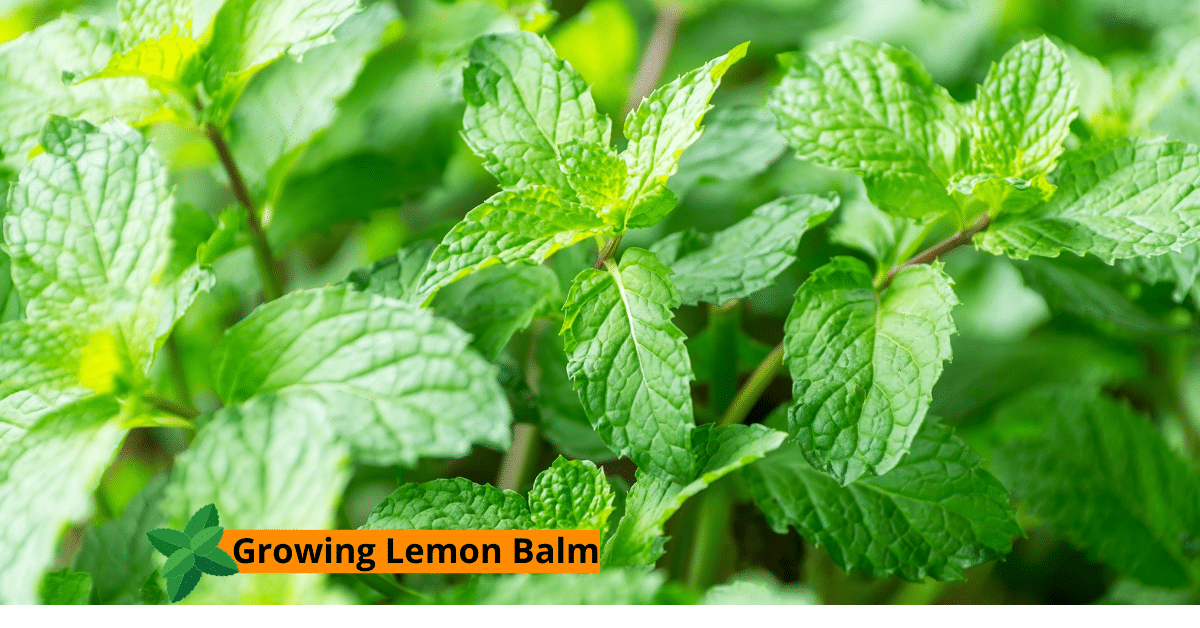Planting Growing and Harvesting Lemon Balm
Growing lemon balm, The lemon balm plant is in the mint family and is a kind of perennial herb. The lemon balm plant is helpful to make medicine, and it has a mild lemon aroma. Sometimes the leaves of lemon balm are used alone or combined with some other products.
Can use Lemon Balm to treat several diseases such as anxiety, stress, insomnia, indigestion dementia, and various other conditions. But many of its uses do not have a shred of scientific evidence to back it up.
The lemon balm herb’s ability to enhance the flavor of foods and salads attracts bees to increase honey production. The lemon balm plant is an ornamental plant, and we extract essential oil from it.
Biological Name
Melissa officinalis
Plant Type
The type of plant is Herbaceous perennial
Maturity Period
It takes seventy days to mature.
Maturity Size
1–2 ft. tall, 1.5–2.5 ft. wide
Soil Type
Well-drained soil.
Soil pH
Neutral to acidic soil.
Exposure
The plant requires at least 6 hours of direct sunlight every day but can grow in partial shades.
Hardiness (USDA Zone)
3–6 (USDA)
Spacing
18-23 inches apart.
Bloom Time
Summertime.
Toxity
It can cause skin irritation. Non-Toxic, when consumed in small dosage.
Flower Color
White color.
Growth Rate
Seed generally sprouts in five to nine days.
Native Zone
We can generally see it in the European region.
Maintenance
Regular and even watering is lemon balm plant need. Lemon balm grows well in moist soil; keeping it in a sunny spot will boost growth.
History:
The lemon balm plant has a history that backs to thousands of years used as a fragrant herb. From the Greek word Melissa which means honey bee, lemon balm leaves are rubbed on the beehive to lure bees to stay together and attract more bees. Throughout history, the lemon balm herb has had an excellent reputation. Even herbalists Avicenna termed it as “it makes the heart merry.”
Famous physician, Paracelsus, stated that this heart could revise every body part, and its preparation is named ensmelissa. King Charles V drank this every day because of its healing properties.
Many considered it “elixirs of youth” in Medieval cordials because it strengthens the heart and increases energy. It has its application in Colonial time by homemakers in salads and chops in butter.
Nutritional facts:
Lemon herb has zero calories. Many health-benefiting essential oils and antioxidant phytochemicals compounds are there in its shoots and stems.
Essential oils like citral, citronellol, linalool, and eugenol are there in the lemon balm plant. All of this together gives this plant antiviral and soothing nerve effect.
When we consume lemon herb tea every day, it can cure morning sickness, nausea, and heartburn. It is also a caffeine-free drink.
It can cure digestive problems, carminative and anthelmintic, are there in the essential oils from the lemon balm plant.
Lemon balm heart infusion has many calming and relaxing effects on the nervous system, proved in many research studies. It can also help in relieving fatigue, headaches, and giddiness.
It also has medical uses, and the balm infusion can help lower blood pressure and improve heart function.
Lemon balm can suppress TSH or thyroid-stimulating hormones. Therefore it has its application in treating Grave’s disease.
Nutrients and minerals for Lemon Balm:
It is best to provide organic fertilizers. Since to provide nutrients and energy to the microorganisms of soil, organic fertilizer is the best way. Organic fertilizers offer macro nutrients to the lemon balm plant. To keep the cost low and returns high, everyone recommends using organic fertilizers.
Professionals suggest growing lemon balm plants in soil that is well-drained and sandy loam. The lemon balm plant does not grow well on wet ground.
Generally, additional feeding beyond soil’s nutrition is trivial for lemon balm plants. To promote growth, we can give light liquid fertilizers. But too much fertilizer can decrease its scent and flavor.
When to plant lemon balm:
It is in calm weather; lemon balm grows good. When it is freezing temperature, the plant will die back to the ground, and it will then grow from roots when it spring. It is best not to grow lemon balm plants in hot and humid climates.
When lemon balm plant is grown outdoors, it is best to sow lemon balm seedlings in spring. We can also sow the lemon plant seedling in late summer. When we want to plant the root division, any time is good in the growing season.
Where to plant lemon balm:
It doesn’t matter that the lemon balm plant is indoor or in an outdoor environment. Generally, the lemon balm plant is like a Sunny spot. The outdoor lemon balm plant can withstand a bit of shade, but the indoor plant needs a lot of sunlight on an average of five to six hours a day. A place like a windowsill is beneficial for the plant; it gets a lot of the sun throughout the day.
Lemon plant grows best outdoors, and when we plant lemon balm plant in early spring, lemon balm plant grows a foot tall. Because of this reason meaning gardeners even choose containers to grow lemon balm plants. This measure is to control its invasive nature.
Lemon balm plants can grow both indoors and outdoors with proper care. Growing it outdoor is the best choice.
How to plant lemon Balm:
To grow a lemon balm plant from a seed, it needs a lot of light to germinate and grow. To start, put the plant seed in a shallow water dish, cover it with a sprinkle of soil. Experts recommended exposing the plate to light and providing enough water so that the source does not dry up. Within 10 to 14 days, we can see the sign of germination.
The division is another method we can grow this plant. When the plant is dormant during early spring or fall, a big part of the established plant. Divide the portions into smaller pieces and then replant them in the ground.
Suppose the gardener wants to grow lemon balm plant in the container. Experts recommend planting the seeds in a pot at least 8 inches deep and 12 to 15 inches wide. We should also take care that the container gets direct sunlight for at least 5 hours a day.
Lemon balm care:
We should water the lemon balm plant regularly and evenly. Light, moist soil is best suited for Lemon balm pants.
The Lemon balm plant tends to grow underground roots. To avoid lemon balm plans in which invasive nature, put it in a bottomless container to put the seeds in place. To remove any unwanted plants before they can become established.
Many suggest cutting the plants half after flowering to encourage a second crop of leaves and compact form. To grow lemon balm in a container, we should choose at least 6 to 8 inches deep. Put the container in a protected area during winter.
Varieties of Lemon Balm Plants:
- Citronella Lemon Balm: generally, this plant takes 7 to 21 days for seeds to germinate. , it is preferred to sow it six to eight weeks before the last Frost.
- Quenlinburger Lemon Balm: this variety of lemon balm plants has the most amount of essential oil. It lives as many cosmetic and medical values hello with a beautiful lemon scent.
- Variegated Lemon Balm: this type of lemon balm plant grows to a height of 5 to 7 inches, and up it is the best choice to grow in pots.
- Aurea Lemon Balm: the leaves of this plant is used to make lemon juice. The most attractive feature of this plant is that it can grow in poor soil.
- Legionella Lemon Balm: this variety of lemon balm plants has the most beautiful aroma. We can use it in salads and soups.
Harvesting and storing Lemon Balm:
During the growing season, use leaves and sprigs only when needed. The lemon balm leaves that are older have the best scent. The leaves that we harvest before the flowering starts in summer are best for drying. It is best to cut the plant in half in autumn. It will encourage new leaves to grow. We should use a pruner to snip leaves and sprigs.
During the growing season, we can harvest a limited amount of lemon balm leaves anytime. When the harvesters decide to gather many leaves for medicine or tea, it is preferred to do it when the flower buds bloom.
After collecting an ample amount of stems, it is now time to process them. There are a lot of ways to dry lemon plant herbs. Drying the leaves ensure that the aroma of the leaves sustains.
Pest and diseases of lemon balm:
Generally, pests do not attack lemon balm plants. One of the most common pests is powdery mildew that harms this plant. Put the plants at the proper distance from each other to avoid this pest. Allowing ample room for the plants to grow will protect them from this pest.
In case of powdery mildew attacks, removing leaves infested and applying a light fungicide is best.
Recipes:
Salads: In vegetables and salads, lemon balm leaves can change the entire taste.
Seafood: freshly chopped leaves of lemon balm plant can add extra flavor.

